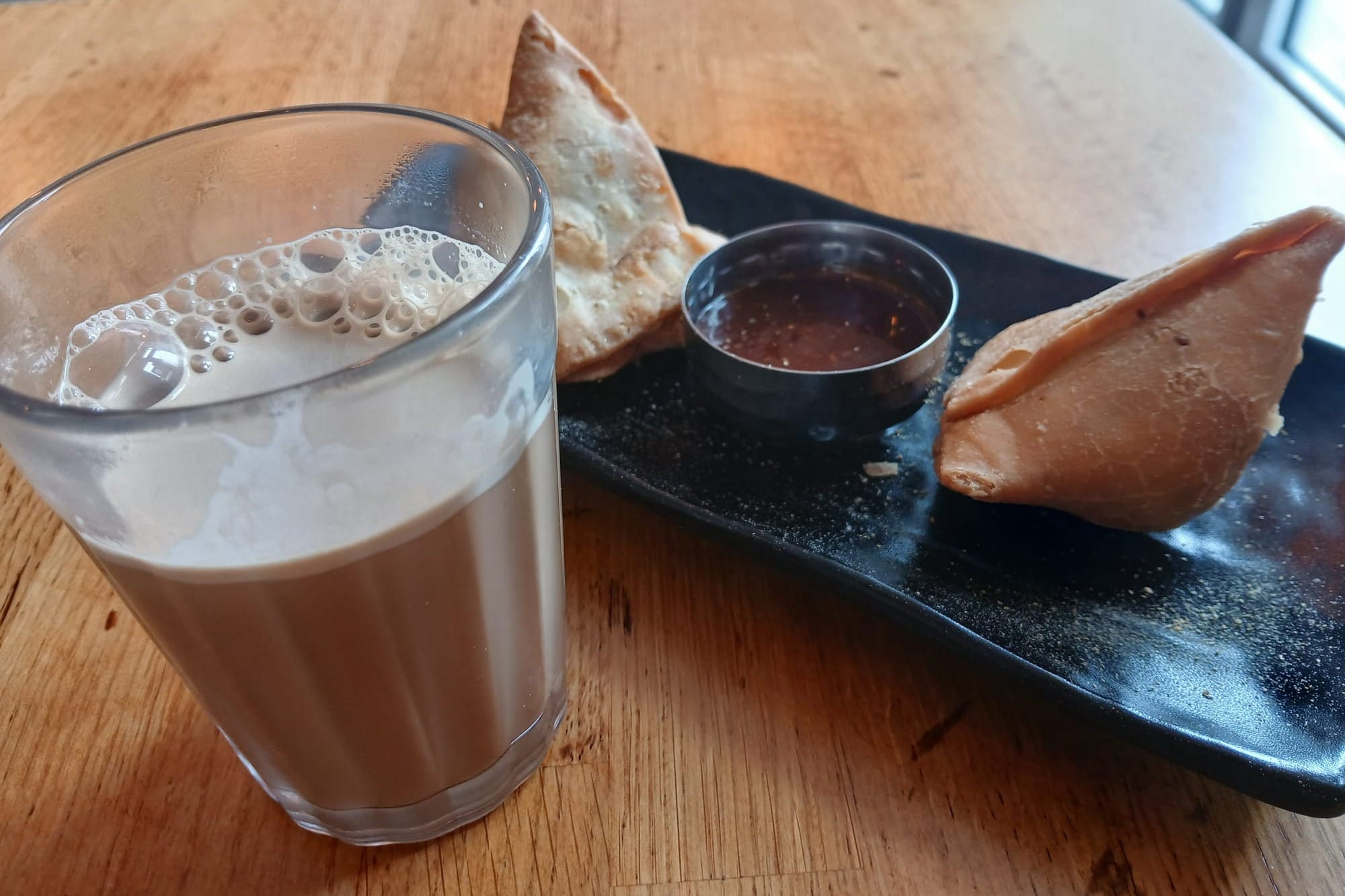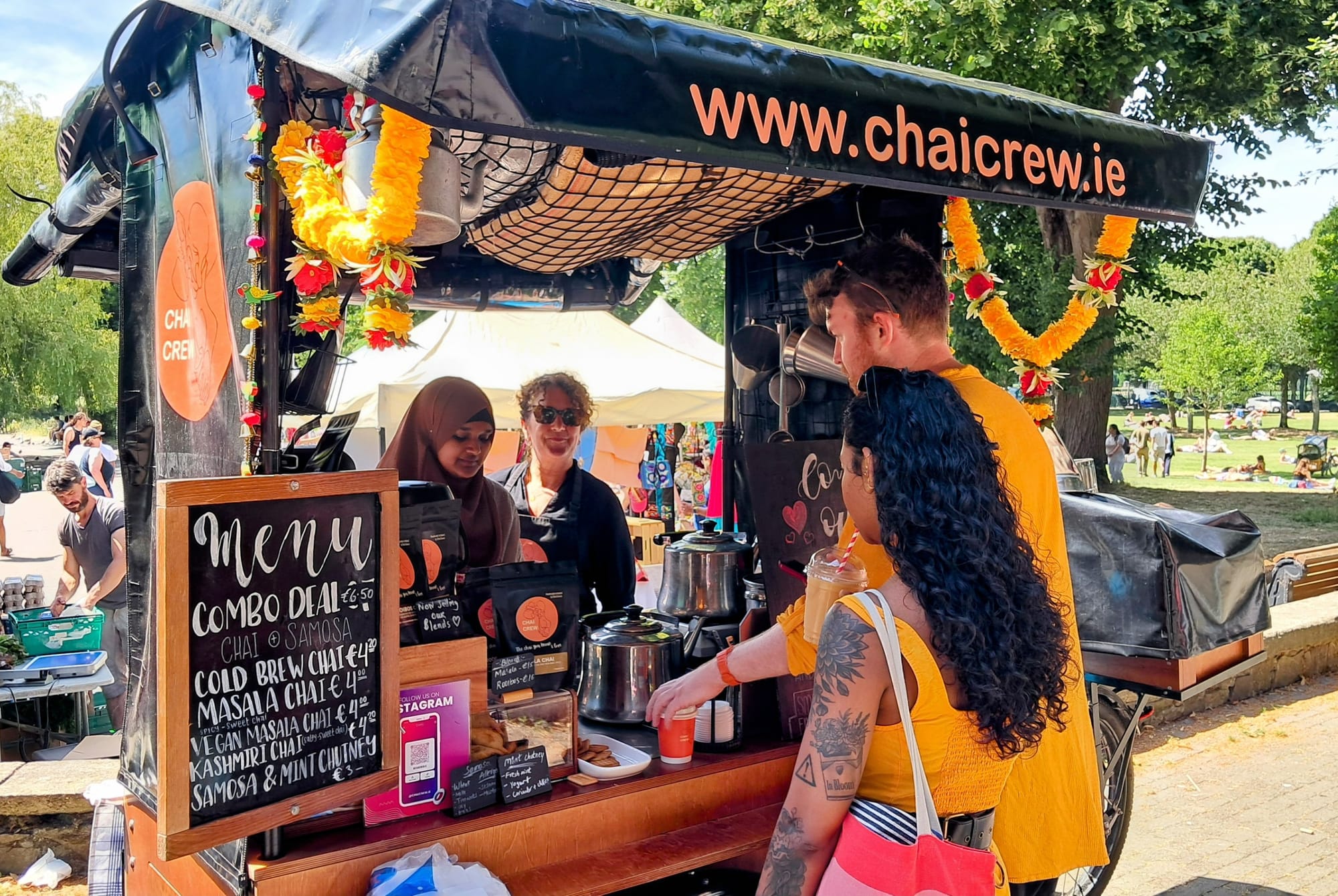Things To Do: Discuss the future of the arts, acquire merch, study the ethnographer’s gaze
Our latest recommendations, and community noticeboard listings.
From Chai Crew at Herbert Park to Chai & Chaat in Essex Quay, spiced teas once limited to diasporic kitchens are becoming easier to find.

Steam curled from a steel pot perched on a retro tricycle at Herbert Park Market on a recent sunny Sunday morning.
The scents of cinnamon, clove, and cardamom lure a crowd.
Eímear Simms, founder of Chai Crew, stirs her fragrant blend of tea and spices, her movements fluid and practiced, as she chats with a regular who cycles in from his home every week.
“There’s something about the spices that just draws people in,” says Simms, gently pouring the frothy chai from kettle to kettle. “People come for the taste, but they stay for the experience.”
Around her, people sip slowly.
Some close their eyes at the first warming hit of ginger and cardamom. Others linger, cups in hand, chatting with strangers. At the edge of the crowd, a man from India turns to his friend and smiles: “It smells like home.”
Once a drink most Dubliners only encountered while traveling, chai is finding new ground in the city.
From Chai Crew at Herbert Park to Chai & Chaat in Essex Quay and even masala chai at Tadka House, the spiced teas once limited to diasporic kitchens are becoming easier to find.
“Masala chai isn’t just India’s most loved drink anymore,” says Simms. “It’s global now.”
Masala chai, black tea brewed with milk, spices, and sugar, is more than a beverage in India. It’s a ritual, a rhythm.
Served in small clay kulhads – glass or paper cups – at roadside stalls, this tradition of tea drinking evolved along colonial railway lines, where chaiwallahs served up steaming cups to weary travellers.
Its history is as layered as its flavour.
Though tea was initially imported from China by the British in the 18th century, a major shift occurred in 1823 with the discovery of native tea plants in Assam, writes Arup K. Chatterjee, a professor of English and author of “Tea Tales – India’s Ever Evolving Chai Culture and the Chai Tapris”.
In the decades that followed, the British intensified efforts to establish their own tea plantations in India. One key moment came in 1848, when Scottish botanist Robert Fortune, on behalf of the British East India Company, disguised himself as a Chinese mandarin and smuggled tea plants, seeds, and cultivation techniques out of China.
This act of botanical espionage laid the foundation for the British-controlled Indian tea industry, reshaping global tea production in the process.
By 1881, the Indian Tea Association had been established. The Tea Cess Bill of 1903 followed, encouraging promotion of tea both at home and abroad.
After World War I, Indian contractors began setting up chai stalls at railway junctions, giving rise to what would become one of the country’s most beloved institutions: the chaiwallah.
Through extensive campaigns in the 1930s, complete with posters in Indian languages and suggested recipes, tea transformed from a colonial import into a shared national habit.
“Indians were practically aliens to the taste of tea even in the late 19th century,” Chatterjee writes. “But within a century, India became a consumer of over 70% of its own produce of the herb.”
But chai’s legacy is not just historical, it is emotional.
The “chai tapri”, meaning a modest kiosk or booth, has become an enduring symbol of this legacy.
Though rooted in India’s railway culture, it has evolved into a contemporary cultural fixture, equally at home on a dusty roadside, or outside a gleaming glass office complex.
These are places where debates erupt, friendships deepen, and politics are unpacked one cup at a time.
For true chai lovers, the experience is almost sacred. The perfect cup must be strong-brewed, deeply spiced, and carry that unmistakable muddy golden-brown hue, not too milky, not too watery, just right.
A well-made cup is judged not only by its taste but by the emotion it evokes.
In India, and increasingly among its diaspora, chai is not just a drink. It’s a moment suspended in time. A companion to early mornings, monsoon afternoons, long train journeys, heartbreaks, heated arguments, and moments of quiet joy.
It’s not just a stall, Chatterjee writes of the chai tapri. It’s "an untarnished shade to pick up the remains of the day with your cup of chai".
Migration from South Asia, a chai-drinking region, has seen a marked uptick in recent years, show figures from past censuses.
The Indian-born population in Ireland more than doubled between the 2011 and 2022 censuses, from about 18,000 to about 57,000, according to Central Statistics Office data.
The numbers of people born in Pakistan, Bangladesh and Nepal who were living in Ireland also grew fast – from about 12,000 combined in 2011 to 21,000 by 2022.
Many have arrived to work in the city’s tech and healthcare sectors, or to study at universities. Along with them, has come the quiet rise of chai.
At Chai & Chaat on Essex Quay, steaming masala chai is paired with crispy samosas and spicy momo, offering a full Indian and Nepali street food experience.

In the city centre, South Indian canteens like Dosa Dosa and Andhra Bhavan keep pots of milky, cardamom-laced tea simmering quietly on the stove, ready to be ladled out alongside dosa breakfasts and lunchtime thalis.
Chaska IFSC and chains like Mini India, with branches across Dublin, have also become go-to spots for those craving the strong, spiced flavours of home.
“A month back, I saw Chai Crew near my workplace,” says Sanjay, a regular customer of Chai Crew, who moved to Ireland from Nepal. “I know how chai is made in my country; it’s a little different, but I love it.”
“She doesn't use some random packet or syrup. That’s great,” he says of Simms’ brew. “Not just good, it is great. She’s not from South Asia, but she really loves the drinks we grew up with. That means a lot.”
Simms tasted her first real chai in 2019 while travelling solo in Northern India, she says.
It was in Rishikesh, Simms says. “Every single day I’d seek out a different chaiwallah. The experience of the chaiwallah stand where people from all different levels of society would come. It was a lovely, welcoming spot. You could have your chai and a biscuit. It felt very safe, very lovely.”
When she returned to Ireland, she found herself searching in vain. “I was looking for a decent chai, but couldn’t find any. It was disappointing. I thought, ‘Gosh, if people knew what a wonderful drink it is when it’s made properly.’”
That longing became the seed of something new.
She realised there is a niche in the market for an alternative hot beverage, she says. “People are questioning their coffee intake. There are definitely tea drinkers who’d be attracted to this. I knew once they tasted a real chai, they’d be converted.”
Simms then reached out to Kuldeep Singh Pundir, who is a chef at Tadka House – and happened to be from Rishikesh – to learn the art of brewing a perfect cup of chai.
“After two chai-brewing sessions, I had to go and make my own chai recipe. In total, I spent six months in my kitchen making chai until I finally got my blend right,” says Simms.
The aromatic mix of warming ginger, green cardamom, cinnamon, cloves and black pepper that hits in that first sip and leads customers to go, ‘Mmmmm this is so good’, says Simms.
She fused her two passions, chai and cycling, coming from a family of cyclists, and designed a bicycle café in 2023.

“I was intrigued by the sound of it,” says Paul, a customer who hails from Liverpool but now lives in Dublin, back at the cycle-stall in Herbert Park.
“On my first taste, I thought it was revolting. Too much cardamom in it. But then, by the end, I said to my partner, ‘I think this is something I’m gonna get addicted to. It’s fantastic,’” he said.
Says Simms: “I didn’t grow up with the tradition of chai, but we all know it’s the things we’ve only recently got to know that we enjoy the most. That’s true for food and drinks, and definitely for chai.”
As demand has grown, Simms has started packaging her custom blend for wholesale and retail with support and mentoring from Nicola Kearns, founder of Niks Tea.
She is fielding requests from cafes looking to serve Chai Crew brews, she says. “That’s a massive validation. And we’re exploring adding more bikes, maybe even outside Dublin.”
Many of Chai Crew’s customers said that, for them, chai isn’t just a beverage, it’s a ritual and a moment to pause. And perhaps that’s what’s resonating most in a city where connection often feels fleeting.
“I’m inviting people to bring a new ritual into their lives,” says Simms. “That moment to sip, connect, breathe. In this fast-paced world where loneliness and disconnect are increasing by the day, that’s no small thing.”
CORRECTION: At 10.22am on 25 July 2025 we made some small adjustments to the paragraph quoting Chatterjee as saying a chai tapri is "an untarnished shade to pick up the remains of the day with your cup of chai", to ensure we quoted exacty what he said.